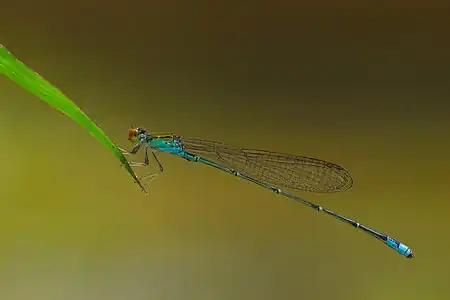Pseudagrion rubriceps
Pseudagrion rubriceps,[2][1] saffron-faced blue dart,[3][4] is a species of damselfly in the family Coenagrionidae. It is found in many tropical Asian countries.[1][5]
| Saffron-faced blue dart | |
|---|---|
 | |
| Male | |
-_Female_W_IMG_3613.jpg.webp) | |
| Female | |
| Scientific classification | |
| Domain: | Eukaryota |
| Kingdom: | Animalia |
| Phylum: | Arthropoda |
| Class: | Insecta |
| Order: | Odonata |
| Suborder: | Zygoptera |
| Family: | Coenagrionidae |
| Genus: | Pseudagrion |
| Species: | P. rubriceps |
| Binomial name | |
| Pseudagrion rubriceps Selys, 1876 | |
| Synonyms | |
| |
Description and habitat
It is a medium sized damselfly with bright orange eyes, greenish below. The male is easily distinguished from all other Pseudagrion species by the brilliant reddish-orange face, from which it derives its common name. Its thorax is olive green above and azure blue on the sides. There is a narrow mid-dorsal carina and humeral stripes in black. Abdomen is blue on the sides, broadly marked with black on dorsum, up to segment 8. Segments 9 and 10 are azure blue without any marks. Anal appendages are black.[6]
Eyes, face and thorax of the female is yellowish green, marked as in the male. Color of the abdomen is similar to the male; but paler. Segments 8 and 9 are also black with fine apical blue rings. Segment 10 is pale blue.[6]
Widely distributed throughout the plains and submontane areas. It breeds in weedy streams and ponds.[6][7][8][3][4]
Subspecies
Two subspecies recognized.[9]
References
- Pal, M. (2011). "Pseudagrion rubriceps". IUCN Red List of Threatened Species. 2011: e.T167385A6339532. doi:10.2305/IUCN.UK.2011-1.RLTS.T167385A6339532.en. Retrieved 20 November 2021.
- Paulson, D.; Schorr, M.; Abbott, J.; Bota-Sierra, C.; Deliry, C.; Dijkstra, K.-D.; Lozano, F. (2023). "World Odonata List". OdonataCentral, University of Alabama. Retrieved 14 Mar 2023.
- "Pseudagrion rubriceps Selys, 1876". India Biodiversity Portal. Retrieved 2017-03-07.
- "Pseudagrion rubriceps Selys, 1876". Odonata of India, v. 1.00. Indian Foundation for Butterflies. Retrieved 2017-03-07.
- K.A., Subramanian; K.G., Emiliyamma; R., Babu; C., Radhakrishnan; S.S., Talmale (2018). Atlas of Odonata (Insecta) of the Western Ghats, India. Zoological Survey of India. pp. 179–180. ISBN 9788181714954.
- C FC Lt. Fraser (1933). The Fauna of British India, including Ceylon and Burma, Odonata Vol. I. Red Lion Court, Fleet Street, London: Taylor and Francis. pp. 296–299.
- C FC Lt. Fraser (1924). A Survey of the Odonate (Dragonfly) Fauna of Western India and Descriptions of Thirty New Species (PDF). p. 497.
- Subramanian, K. A. (2005). Dragonflies and Damselflies of Peninsular India - A Field Guide.
- "Archived copy" (PDF). Archived from the original (PDF) on 2015-02-20. Retrieved 2015-02-20.
{{cite web}}: CS1 maint: archived copy as title (link) - "Pseudagrion rubriceps Selys, 1876".
External links
![]() Data related to Pseudagrion rubriceps at Wikispecies
Data related to Pseudagrion rubriceps at Wikispecies
![]() Media related to Pseudagrion rubriceps at Wikimedia Commons
Media related to Pseudagrion rubriceps at Wikimedia Commons
